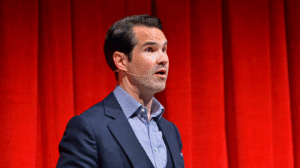In February 2019, an indignant opinion piece appeared in the Independent by one Liam Evans, a self-proclaimed “comedy aficionado” who believed that comedians ought to be subject to criminal investigation for “problematic jokes”. The piece was derided by some as alarmist, but three years on, the controversy over Jimmy Carr’s Holocaust joke has prompted the Culture Secretary to propose something similar: a new law that would make it illegal for streaming services to broadcast offensive comedy.
A spokesperson for the Prime Minister echoed her response, saying that he is looking into “toughening measures for social media and streaming platforms which don’t tackle harmful content on their platforms”. SNP Councillor Julie McKenzie has called for Carr to be “prosecuted” along with “his applauding audience”. Liam Evans, it seems, was simply ahead of his time.
The key difference is that Liam Evans does not exist. The article was a hoax, intended to draw attention to the ideological drift of the mainstream media. (For those who are interested, if you take the fourth letter of every sentence in the article the true author is revealed.)
But the success of the hoax raised a number of questions. How is it that a national media organisation would publish such absurd and authoritarian drivel by a complete unknown? Are their editorial standards really so low? And does their decision to publish the article suggest that they support the author’s calls for comedy to be regulated by the state? If so, Liam Evans was simply a useful tool, someone the Independent could promote who was prepared to say the quiet part out loud.
There has always been satirical potential in hoaxing. In the Sixties, for instance, a series of letters was dispatched to the press by Mrs Edna Welthorpe, who was enraged by the depravity of Joe Orton’s farces, which were dominating the West End. Of Entertaining Mr Sloane, Welthorpe wrote: “I myself was nauseated by this endless parade of mental and physical perversion. And to be told that such a disgusting piece of filth now passes for humour!”
When an audience member wrote a letter of complaint to the Criterion Theatre about Orton’s Loot, Welthorpe responded directly, claiming that she was an employee and that the letter had been passed to her for filing. “Please, please, as a fellow Christian, let me applaud your design in writing to the Lord Chamberlain,” she wrote. “This truly horrible play shouldn’t contaminate our streets.”
That Orton should assume a persona to fulminate against his own plays was simply his way of broadening the scope of his satirical work from the stage to the real world. He was obsessed with the sham gentility of a society that was, to his mind, essentially rotten. Orton loved to shock, perhaps because he was seemingly incapable of being shocked by anything. In his plays, he was able to take a hacksaw to those figures of authority he so despised, be they doctors, police officers, or any other breed of moralising hypocrite. But the hoax letters served a different purpose. They mocked their targets through the pretence of sympathy, effectively encouraging more of the kind of behaviour that his farces sought to lampoon.
This technique is the precursor to what we now call “trolling”. The term is often misused as a synonym for malicious and bullying online behaviour but, as traditionally understood, trolling is the art of coaxing people into a reaction. Motivations vary from troll to troll. For some, it is simply a matter of revelling in the gullibility of strangers. For others, the intention is to expose the vices and shortcomings of those in power.
Jonathan Swift was an early exponent of this kind of trolling in the creation of his alter-ego Isaac Bickerstaff, who wrote pamphlets which predicted, and then announced, the death of the astrologer John Partridge. Swift resented Partridge because of his attacks on the church, and must have been immensely gratified that Bickerstaff’s announcement had been taken on trust by so many. It is said that Partridge was thereafter continually having to fend off queries about his uncanny resemblance to a dead man.
Of course, many hoaxers are driven purely by self-interest. When, in 1806, Mary Bateman used concentrated vinegar to write “Christ is coming” onto her chicken’s eggs, and then charged members of the community to visit her “Prophet Hen of Leeds”, it is unlikely that she intended to make any kind of satirical point.
Yet one might argue that even in hoaxes of this kind there is some societal insight to be gleaned, however inadvertently. Mary Toft managed to destroy the reputations of a number of prominent surgeons who, in 1726, believed that she had given birth to rabbits. One of the king’s doctors, Nathaniel St. André, was so convinced that he published A Short Narrative of an Extraordinary Delivery of Rabbets. Soon after, William Hogarth produced his Cunicularii, which depicts Mary Toft in labour, surrounded by learned men of the medical profession, while multiple rabbits roam at their feet. If Toft was no satirist, she at least inspired some of the best of her age.
Perhaps the most celebrated instance of satirical hoaxing in our lifetime was Chris Morris’s television series Brass Eye (1997), which took aim at celebrity and media culture by inviting public figures to join campaigns against entirely fabricated social justice causes. In one episode, Bernard Manning, Rolf Harris and Noel Edmonds were enlisted to warn against the dangers of “cake”, a fictitious drug that, as Manning dutifully informed viewers, caused one girl to vomit out her own pelvis.
In another episode, Nick Owen expounded on the dangers of “heavy electricity” which, due to the effect of “sodomised electrons” was “regularly flattening cattle in Sri Lanka”. Then there was the radio DJ Neil Fox, who was tricked into making this astonishing claim: “Genetically, paedophiles have more genes in common with crabs than they do with you and me. Now, that is scientific fact. There’s no real evidence for it, but it is scientific fact.”
Many of those duped by Morris were seemingly happy to read aloud any hogwash from an autocue in return for television exposure and the impression that they were on the right side of history. Such hoaxes could potentially be even more effective in today’s climate, with so many soft-witted celebrities eager to endorse fashionable but illiberal notions they barely understand. All major political, educational, artistic and corporate bodies are seemingly in submission to a new identity-obsessed religion of “social justice” that couches its regressive ideas in progressive terminology.
But, unlike the days of Brass Eye, the jesters are now in lockstep with these establishment lines, and so the most pertinent sources for satire are generally left untapped. They are, as Morris recently put it, more interested in “doing some kind of exotic display for the court” than exposing the follies of the powerful.
It is perhaps inevitable, then, that one of the most impressive hoaxes of recent years has come from outside the comedy industry. In October 2018, it was revealed that Peter Boghossian, James Lindsay and Helen Pluckrose had spent a year writing and submitting bogus academic papers to various journals in order to show how certain branches of the humanities were now routinely prioritising ideological goals over the pursuit of truth and knowledge. By the time the hoax was exposed, seven of their 20 articles had been accepted for publication, and a further seven were in the process of review.
As a work of satire, this project was an undoubted success. It provided evidence of what many had long suspected, that nonsensical ideas could thrive within the academy so long as they were camouflaged in vogueish jargon. One paper purported to be a study of the sexual activity of dogs in urban parks, and used this phoney data to draw conclusions about contemporary “rape culture”. Another argued that white male students ought to be chained to the floor during lessons as a form of reparation for slavery. Most audacious of all was the article based entirely on a chapter of Mein Kampf, rewritten in the language of intersectional feminist theory.
That all of these articles were accepted for publication in peer-reviewed journals should have alerted academics to a troubling strain of corruption and fraudulence in their field. They should have resolved to rectify the problem, but instead chose to demonise and smear the hoaxers who had exposed it. When satirists hit on uncomfortable truths, they are rarely thanked for their efforts.
It has become a truism that we are living during a period in which satire and reality are not easily distinguishable. Ten years ago, headlines such as “Can my children be friends with white people?” and “Transgender man gives birth to non-binary partner’s baby with female sperm donor” would have been dismissed as the fevered concoctions of Viz or the National Enquirer (they are, in fact, from the New York Times and the Mirror).
For all that, there are opportunities to be seized in such a climate of institutionalised asininity. While trust in figures of authority is plummeting, and people are no longer sure who or what can be believed, the conditions are ripe for a new generation of Joe Ortons and Mary Tofts to cause some necessary mischief. In an age of unreason, the hoaxer can thrive.
Disclaimer
Some of the posts we share are controversial and we do not necessarily agree with them in the whole extend. Sometimes we agree with the content or part of it but we do not agree with the narration or language. Nevertheless we find them somehow interesting, valuable and/or informative or we share them, because we strongly believe in freedom of speech, free press and journalism. We strongly encourage you to have a critical approach to all the content, do your own research and analysis to build your own opinion.
We would be glad to have your feedback.
Source: UnHerd Read the original article here: https://unherd.com





